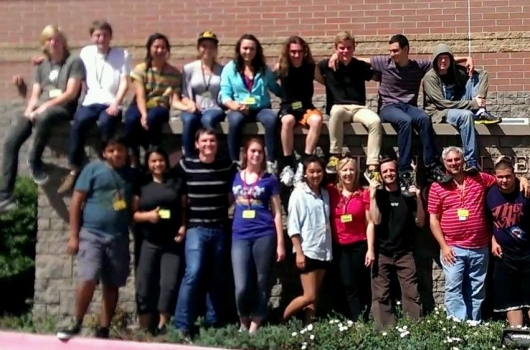Autism and Youth: The Bigger Picture

In summer 2013, I took a group of youth from Los Angeles to volunteer with the children at the Tennyson Center in Denver, CO, and I’ll never forget the morning of our departure. A 16-year-old member of our group – I’ll call him “Aaron” – arrived at the church parking lot wearing a hard hat and carrying a hammer. A hard hat, in retrospect, wasn’t necessarily the worst choice for work involving dozens of high-energy kids. But I gently suggested that maybe it would be best to leave the hammer with his mom.
Aaron was on the autism spectrum – one of several youth in our group with this cognitive difference. I’d like to think the congregation had created a safe space where differences could be celebrated as part of the tapestry of God’s creative genius.
But I also remember thinking that God had a sense of humor in calling me to this ministry. I had zero experience with autism, and I thought teaching youth was primarily about fostering a sense of context, nuance, and “the big picture” – some of the capacities that are often most challenging for Autism Spectrum Disorder (ASD) youth. As I got to know these beautiful children of God, I had to rethink not only my pedagogy, but also my very assumptions about the ways in which the Spirit shapes and transforms.
Perhaps There’s Another Way
If we’re all created in the image of God, does it not follow that something of the Divine is revealed in Aaron’s way of understanding the world? And if God’s grace is meant for all, is Aaron not capable of a sort of faith that is pleasing to God? I’m still no expert in autism, but I would answer those questions with a resounding “Yes!”
And so…in humility and trust, we did several things to try to support our ASD youth in their journeys of faith:
- We made a special effort to help our “neurotypical” youth understand that ASD youth are different – not broken – and that difference is to be celebrated. Like any teenagers, we knew our ASD youth wanted to feel loved and included, so these efforts were especially important to us.
- Where possible, we tried to create opportunities for small group (or one-on-one) discussion driven by our ASD youth, allowing them to share from their own experiences.
- We tried to offer a diversity of activities within the ministry, each targeting different learning and cognitive styles.
- And where possible, we tried to provide extra adults during our group meetings to be aware of the needs of our ASD youth. Sometimes Aaron would decide that an activity just wasn’t working for him, and this extra adult would be ready to break off and help him engage in another way.
These last two points proved critical during our mission trip to Colorado. It quickly became clear that working with the children of the Tennyson Center was going to be out of the question for Aaron. The work required rapid processing, deep empathy, and a profound sense of context, and these simply weren’t his strengths. It was, to use Aaron’s words, “really hard,” and he seemed deeply distressed by the situation.
It was then that I remembered the hammer and hard hat, and it struck me: what I had passed off as a silly misunderstanding was really something else. It was Aaron’s way of putting his best foot forward. He didn’t know what to expect in Colorado, but he wanted desperately to be a blessing, and he knew he was good at serving others through physical work. Showing up in a hard hat was his Isaiah 6:8:
“Here I am. Send me!”
Aaron perked up when the Tennyson staff graciously offered an alternative: there was a craft supply room in desperate need of reorganizing. Aaron and one of our youth leaders spent the next few days working on that room, and the task made sense to him. He beamed with joy when he stood back at the end of the week and admired his handiwork.
The next year, the youth of our church really wanted to return to the Tennyson Center, and I was worried about what this would mean for Aaron. After discussing it with him, I was impressed by his conclusion:
“I don’t think that work is a good fit for me, but I want the group to go.”
And so we did.
But the group also decided to spend a day helping to remodel a home for a church family in need, and I was pleased when they nominated Aaron to be “lead contractor.”
“But as it is, God arranged the members in the body, each one of them, as God chose.” – 1 Corinthians 12:18
Print-friendly version here! >>
Rev. Justin Jeter is currently the Associate Minister at First Christian Church of Granbury, TX. Rev. Jeter is a guest blogger for the NBA Mental Health and Congregational Care Affinity Group Research and Design Team. This team will work through December 31, 2015, to define the purpose and goals of a full Affinity Group to launch in early 2016. This is effort is in response to the passing of GA-1523“Becoming a People of Welcome and Support to People with Mental Illness and/or Mental Health Issues” by the 2015 General Assembly of the Christian Church (Disciples of Christ). For more information, please email mkilpatrick@nbacares.org.
Tennyson Center for Children at Colorado Christian Home works with children, youth, and their families to overcome a variety of life crises, including abuse and neglect, by providing competent and caring treatment, education, and advocacy services that are community-based, family-focused, and child-centered. Tennyson Center is a participant in the NBA’s Disciples Care Exchange. For more information about the Disciples Care Exchange, please email mkilpatrick@nbacares.org.